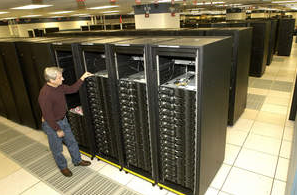IBM wins supercomputing bakeoff; Playstation chips rule; Intel dominates HPC

Supercomputers are like muscle cars for IT: Few of us have one, but boy they are fun to look at.
IBM on Tuesday touted that its supercomputer built for the National Nuclear Security Administration's Los Alamos National Lab is the most powerful system in the world. It sustained 1.02 petaflops or a 1.02 quadrillian calculations per second.
Confession: I can't even wrap my little head around a term like quadrillian. But it's all good fun.

After IBM's supercomputer, dubbed "Roadrunner," the final four fastest systems were:
- The IBM BlueGene/P (450.3 teraflop/s) at DOE's Argonne National Laboratory
- The Sun SunBlade x6420 "Ranger" system (326 teraflop/s) at the Texas Advanced Computing Center at the University of Texas - Austin.
- The upgraded Cray XT4 "Jaguar" (205 teraflop/s) at DOE's Oak Ridge National Laboratory.
These bake-offs are a big deal for technology's biggest players although these wins don't exactly make or break quarters. It's all about the bragging rights.
Big Blue says in its statement:
Built by IBM for the NNSA and housed at its Los Alamos National Laboratory, the petaflop-smashing system gets its world-leading power from 12,240 IBM PowerXCell 8i Cell Broadband Engine(TM) processors -- derived from chips that power today's most popular videogame consoles. 6,562 AMD Opteron Dual-Core processors perform basic compute functions, freeing the IBM PowerXCell 8i chips for the math-intensive calculations that are their specialty.
This "hybrid" architecture, which optimizes the strength of multiple types of processors, is an IBM hallmark. The design is analogous to that of a hybrid car with similar benefits. For example, if the NNSA supercomputer were built with standard x86 chips alone, the system would have been significantly larger and would have required much more power.
At least all those Cell processors are being used for more than gaming on the Playstation 3. The NNSA supercomputer keeps tabs on the United States nuclear stockpile.
Among the key points about Roadrunner:
- It's made from commercial parts and gives AMD a nice win. Roadrunner connects 6,948 dual-core AMD Opteron chips (on IBM Model LS21 blade servers) as well as 12,960 Cell engines (on IBM Model QS22 blade servers). The Roadrunner system has 80 terabytes of memory, and is housed in 288 refrigerator-sized, IBM BladeCenter racks occupying 6,000 square feet. Its 10,000 connections -- both Infiniband and Gigabit Ethernet -- require 57 miles of fiber optic cable. Roadrunner weighs 500,000 pounds so it's not exactly portable.
- Roadrunner runs on a "tri-blade" configuration. IBM did a custom configuration where it combines two IBM QS22 blade servers and one IBM LS21 blade server. There are 3,456 tri-blades in Roadrunner.
- Roadrunner will be shipped to Los Alamos on 21 tractor trailers later this summer. The machine was built in IBM's Poughkeepsie plant.
While Roadrunner gives AMD some attention a few nuggets from the Top 500 list put things into perspective. Among the notable items:
- Intel continues to power an increasing number, with Intel processors now found in 75 percent of the TOP500 supercomputers, up from 70.8 percent in November's list.
- Quad-core processor based systems have taken over the top 500 list with 283 systems using them. Dual core systems power 203 systems and 11 systems have single cores. Three systems use IBM's Sony Playstation 3 processor with nine cores.
- The U.S. is the leading consumer of HPC systems with 257 of the 500 systems.
- The European share (184 systems - up from 149 in November) is rising with Asia lagging (48 systems down from 58 systems).
- The top industrial company is Total, the French oil company.
- HP is giving IBM a run. Among the top 500 list, IBM held the lead with 210 systems (42 percent) over Hewlett Packard with 183 systems (36.6 percent). The catch: IBM had 232 systems (46.4 percent) six months ago, compared to HP with 166 systems (33.2 percent).
- The top 500 list is tracking power consumption. IBM's QS22 Cell processor blades are delivering up to 488 Mflop/s/Watt followed by IBM BlueGene/P systems (up to 376 Mflop/s/Watt). Intel quad core blade systems are catching up though: IBM's BladeCenter HS21with low-power processors (up to 265 Mflop/s/Watt), SGI's Altix ICE 8200EX Xeon quad-core nodes, (up to 240 Mflop/s/Watt) and Hewlett-Packard Cluster Platform 3000 BL2x220 with double density blades (up to 227 Mflop/s/Watt) round out the next power efficiency tier.
Here's a look at the top 10: